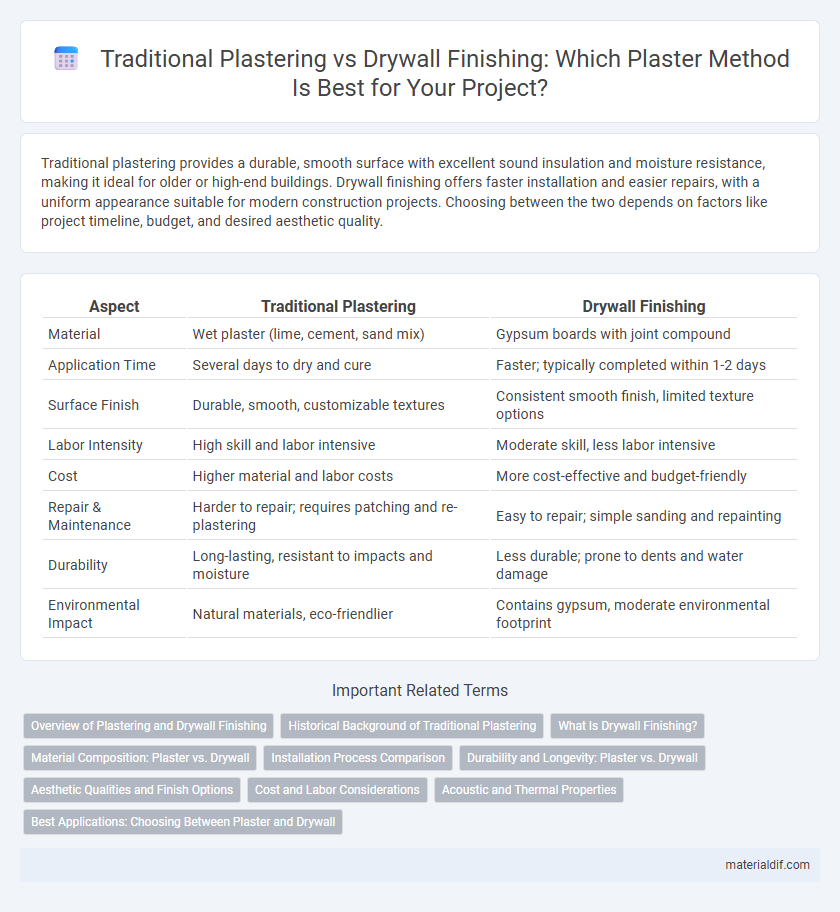Traditional plastering provides a durable, smooth surface with excellent sound insulation and moisture resistance, making it ideal for older or high-end buildings. Drywall finishing offers faster installation and easier repairs, with a uniform appearance suitable for modern construction projects. Choosing between the two depends on factors like project timeline, budget, and desired aesthetic quality.
Table of Comparison
| Aspect | Traditional Plastering | Drywall Finishing |
|---|---|---|
| Material | Wet plaster (lime, cement, sand mix) | Gypsum boards with joint compound |
| Application Time | Several days to dry and cure | Faster; typically completed within 1-2 days |
| Surface Finish | Durable, smooth, customizable textures | Consistent smooth finish, limited texture options |
| Labor Intensity | High skill and labor intensive | Moderate skill, less labor intensive |
| Cost | Higher material and labor costs | More cost-effective and budget-friendly |
| Repair & Maintenance | Harder to repair; requires patching and re-plastering | Easy to repair; simple sanding and repainting |
| Durability | Long-lasting, resistant to impacts and moisture | Less durable; prone to dents and water damage |
| Environmental Impact | Natural materials, eco-friendlier | Contains gypsum, moderate environmental footprint |
Overview of Plastering and Drywall Finishing
Traditional plastering involves applying multiple wet layers of plaster directly onto walls or lath to create a durable, smooth surface with excellent sound insulation and fire resistance. Drywall finishing uses gypsum panels attached to framing, followed by taping, mudding, and sanding joints for a quicker, cost-effective installation that allows for easier repairs. Both methods provide a finished wall surface, but plaster offers greater longevity and texture options, while drywall is favored for speed and convenience in modern construction.
Historical Background of Traditional Plastering
Traditional plastering dates back thousands of years, with early civilizations like the Egyptians and Romans using lime-based plasters to create durable and decorative wall finishes. This technique involves applying multiple layers of wet plaster, allowing skilled artisans to sculpt intricate textures and ornamental details. Despite the rise of modern drywall, traditional plastering remains valued for its authentic aesthetic and superior soundproofing qualities.
What Is Drywall Finishing?
Drywall finishing involves applying joint compound to drywall seams, screw holes, and corners to create a smooth, seamless surface ready for painting or wallpapering. Unlike traditional plastering, which uses wet plaster applied over lath, drywall finishing relies on taping, mudding, and sanding techniques to achieve a clean, uniform finish efficiently. This method is widely preferred in modern construction for its speed, cost-effectiveness, and minimal drying time.
Material Composition: Plaster vs. Drywall
Traditional plaster consists of lime, sand, and water or gypsum, creating a dense and hard surface that offers excellent durability and sound insulation. Drywall finishing uses gypsum boards with a core of pressed gypsum covered by paper faces, allowing for faster installation but less impact resistance. The mineral-based composition of plaster provides superior moisture resistance compared to drywall, making it suitable for a variety of environmental conditions.
Installation Process Comparison
Traditional plastering involves applying multiple wet coats over a lath base, requiring skilled labor and extended drying times that can take several days to weeks. Drywall finishing consists of fastening prefabricated gypsum boards to framing, followed by taping and sanding joints, allowing for quicker installation often completed within a day or two. The wet application and curing of plaster offer superior durability and soundproofing, while drywall finishing enables faster project turnaround and easier repairs.
Durability and Longevity: Plaster vs. Drywall
Traditional plastering offers superior durability and longevity compared to drywall finishing, with plaster walls often lasting over a century without significant damage. Plaster's hard, dense surface resists cracks, dents, and moisture better than drywall, which is more prone to wear and can deteriorate within 10 to 20 years under typical conditions. The longevity of plaster makes it a preferred choice in historic restorations and high-traffic areas, where resilience is critical.
Aesthetic Qualities and Finish Options
Traditional plastering offers a smooth, durable surface with depth and texture that enhances architectural details, delivering a high-quality, seamless finish ideal for historic restoration and custom designs. Drywall finishing provides quicker installation and a uniform flat surface, but typically lacks the nuanced textures and bespoke finishes achievable with plaster. Plaster allows for diverse finish options such as Venetian, lime, and polished plasters, enabling rich aesthetic customization compared to the limited texture choices in drywall.
Cost and Labor Considerations
Traditional plastering involves a labor-intensive process requiring skilled artisans, often resulting in higher labor costs compared to drywall finishing. Drywall finishing is generally faster and more cost-effective, utilizing pre-manufactured panels that reduce installation time and material expenses. The initial investment for traditional plaster can be significantly higher, but it offers superior durability and sound insulation, potentially lowering maintenance costs over time.
Acoustic and Thermal Properties
Traditional plastering offers superior acoustic insulation, absorbing sound waves more effectively than drywall finishing, which often requires additional materials for soundproofing. Thermal properties also favor traditional plaster, as its dense composition provides enhanced thermal mass that stabilizes indoor temperatures and improves energy efficiency. Drywall finishing, while quicker to install, typically lacks the natural insulating qualities of plaster, necessitating supplementary insulation to achieve comparable acoustic and thermal performance.
Best Applications: Choosing Between Plaster and Drywall
Traditional plastering provides a durable, fire-resistant surface ideal for historic restorations and high-end custom finishes, offering superior sound insulation and smooth, seamless walls. Drywall finishing excels in speed, cost-effectiveness, and ease of installation, making it suitable for modern residential and commercial projects requiring quick turnaround and budget-friendly solutions. Selecting between plaster and drywall depends on project requirements such as aesthetic preference, budget constraints, and the desired durability of wall surfaces.
Traditional plastering vs Drywall finishing Infographic

 materialdif.com
materialdif.com